
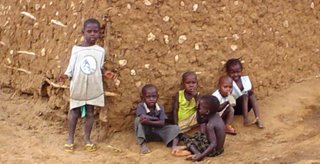







I do believe I’d have to say that my trip to Bangale (pronounced Bon’-ga-lay) and Garissa (Ga-ris’-sa) ranks amongst my most interesting experiences in Kenya. I found it all to be quite fascinating.
The town of Garissa, on the banks of the Tana River and just on the edge of North Eastern Province, is located about 200 miles west, northwest of Nairobi. [I can now boast that I’ve been in each of the eight provinces in Kenya!]



Bangale is located 50 miles before Garissa town. That was our first destination – to visit a missionary named Rita (see my November prayer letter for a photo of her - she's also in the middle photo on the left side of desks). She’s teaching as a volunteer at the Bangale Primary School.
Her aim is to befriend the Somali Muslim students and to eventually share the Gospel with them. Apparently she’s making an impact because they’ve given her the nickname, “Jesus”! I was quite impressed with her spunk!









 As I explained, the Bangale area is arid; rainfall is quite minimal and sporadic.
As I explained, the Bangale area is arid; rainfall is quite minimal and sporadic.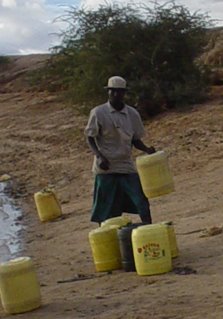 This man is industrious! He came with several jerry cans with which to haul water home.
This man is industrious! He came with several jerry cans with which to haul water home.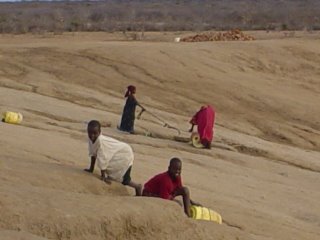

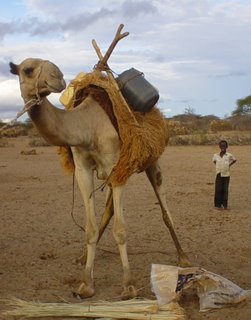
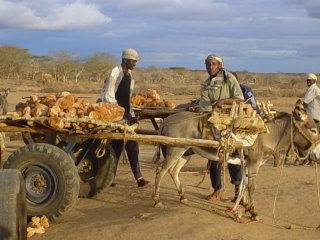 There's been a problem with the water getting dirty. Many people allow their goats, donkeys, cattle, camels, etc to step into the dam in order to drink. Naturally their feet are dirty and then the water gets too dirty for human consumption.
There's been a problem with the water getting dirty. Many people allow their goats, donkeys, cattle, camels, etc to step into the dam in order to drink. Naturally their feet are dirty and then the water gets too dirty for human consumption.
 This woman was very, very hesitant to allow me to take her photo. She shyly told me "no" on each of my initial requests. Eventually she agreed. She's on the community "water committee". She answered many of my questions about the dam.
This woman was very, very hesitant to allow me to take her photo. She shyly told me "no" on each of my initial requests. Eventually she agreed. She's on the community "water committee". She answered many of my questions about the dam. These two guys (one of which is Ahmed) are also on the water committee. They also answered my many questions and proudly told me all about the dam and the trough project. The ONLY reason I got ANY pictures at the dam is because I was with them. They served as my tour guides (so-to-speak) and also served as an intermediary between me (and my white skin and camera) and the reticent people collecting water.
These two guys (one of which is Ahmed) are also on the water committee. They also answered my many questions and proudly told me all about the dam and the trough project. The ONLY reason I got ANY pictures at the dam is because I was with them. They served as my tour guides (so-to-speak) and also served as an intermediary between me (and my white skin and camera) and the reticent people collecting water.
 This is the "market". It sits idle except on market day when folks come from a wide radius to trade goods. The structures are made of sticks. On top, for the roofs, are branches that still have leaves on.
This is the "market". It sits idle except on market day when folks come from a wide radius to trade goods. The structures are made of sticks. On top, for the roofs, are branches that still have leaves on.
 This truly was an interesting sight! When a family needs to move to a different area to hunt for water or pasture, they simply pack up their house and store it in a tree! This isn't the best picture, but I think you can see the yellow bundle. That's their house. The houses are primarily constructed of sticks. The vast majority had a bright yellow plastic tarp over the top for keeping the rain out (if and when it ever rains). Apparently some relief organization provides the yellow plastic.
This truly was an interesting sight! When a family needs to move to a different area to hunt for water or pasture, they simply pack up their house and store it in a tree! This isn't the best picture, but I think you can see the yellow bundle. That's their house. The houses are primarily constructed of sticks. The vast majority had a bright yellow plastic tarp over the top for keeping the rain out (if and when it ever rains). Apparently some relief organization provides the yellow plastic.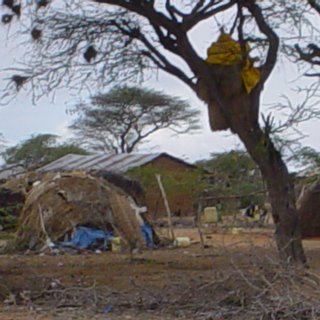 Notice the bundle in the tree. That's another house awaiting the return of the owners. Interesting, huh?
Notice the bundle in the tree. That's another house awaiting the return of the owners. Interesting, huh?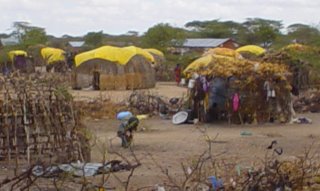

 The bags contain charcoal for cooking fuel. They are sitting alongside the road awaiting a buying customer. This is a very common sight throughout Kenya.
The bags contain charcoal for cooking fuel. They are sitting alongside the road awaiting a buying customer. This is a very common sight throughout Kenya. I think you can see the interesting contrasts. Their homes are built of sticks (or sometimes mud) - both of which are an earth-brown color.
I think you can see the interesting contrasts. Their homes are built of sticks (or sometimes mud) - both of which are an earth-brown color.



